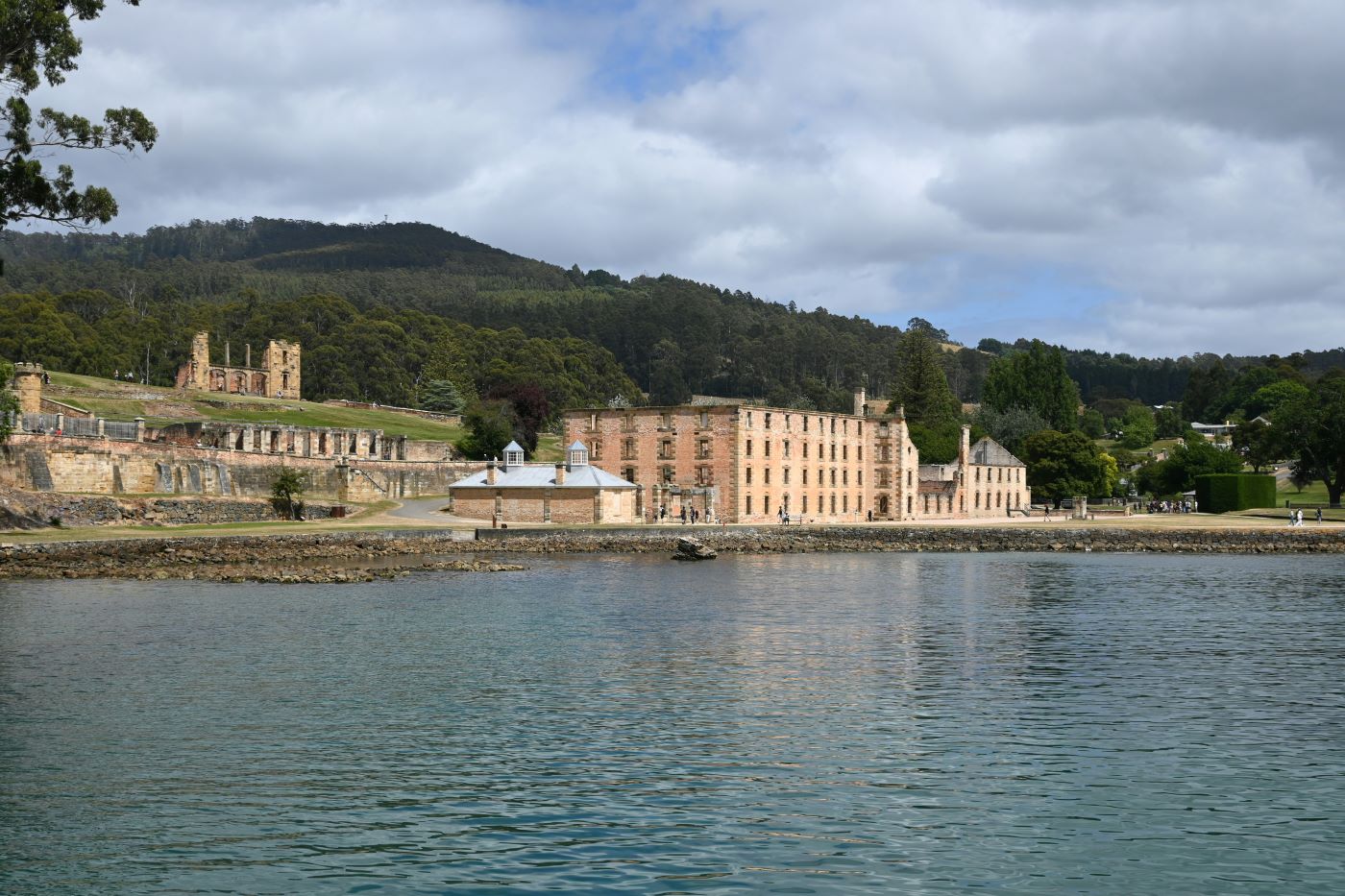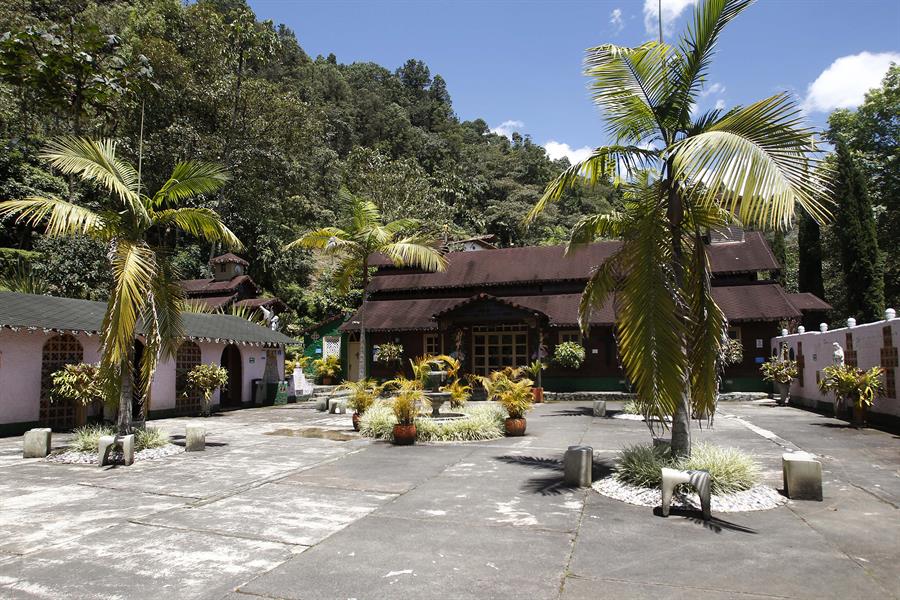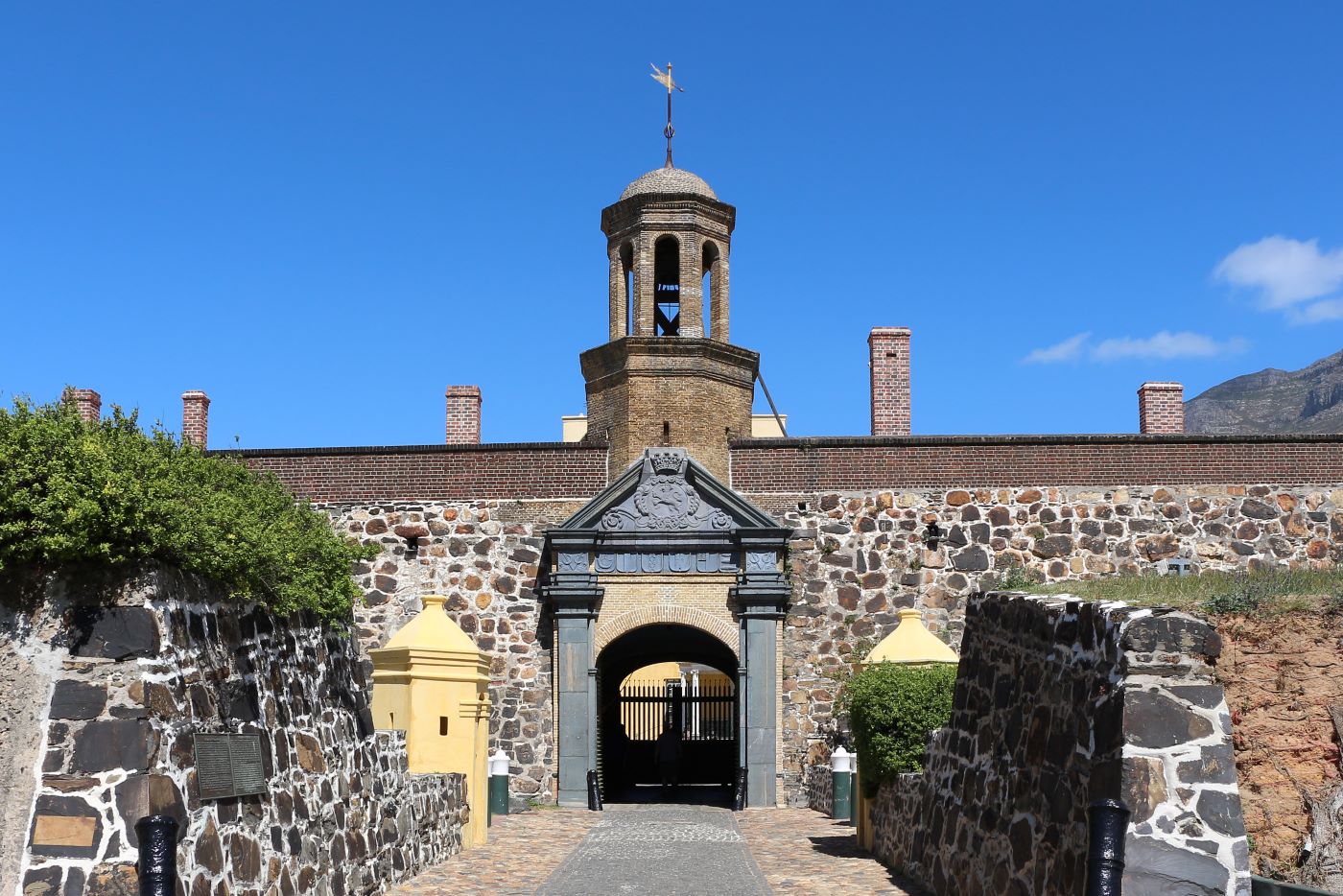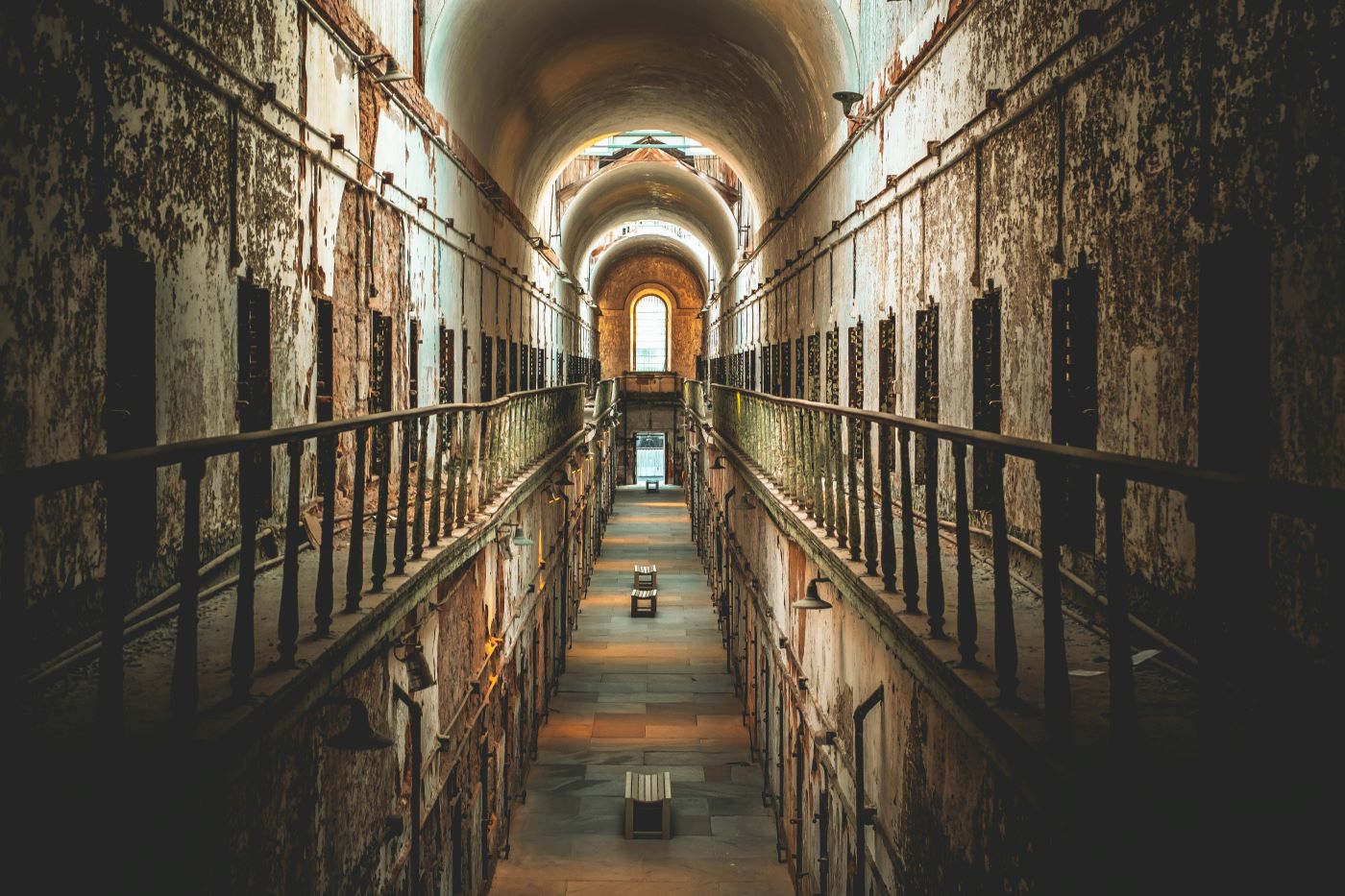To approach the Port Arthur Historic Site is to experience a profound and unsettling cognitive dissonance. Whether you arrive by the winding roads that snake through the dense eucalyptus forests of the Tasman Peninsula or by sea, watching the sandstone cliffs rise like fortress walls from the turbulent Southern Ocean, the first impression is one of breathtaking, almost violent beauty.
The air here is distinct—crisp, salted, and untainted, carrying the chill of the Antarctic currents that circulate just to the south. As you step onto the manicured grounds, the visual data suggests a pastoral paradise. The grass is a shocking, vibrant emerald, fed by the frequent Tasmanian rains. The harbour glitters with a sapphire intensity, framing the ruins in a way that feels curated, almost romantic. Oak and elm trees, planted nearly two centuries ago to mimic the gentle estates of the British aristocracy, cast dappled shadows over the pathways.
But this beauty is a lie. It is a "pastoral deception," a scenic mask worn by one of the most brutal machines of human suffering ever devised. This is not merely a collection of old buildings; it is a landscape where the earth itself seems to remember the weight of the leg irons. For forty-seven years, from 1830 to 1877, this site was the destination for the "worst of the worst"—recidivist convicts who had re-offended after arriving in the colonies. It was the endpoint of the British Empire, a place designed not just to punish the body, but to dismantle the spirit.
To walk these grounds is to experience a kind of intellectual vertigo. Your eyes drink in the serenity of the English gardens, but your mind is forced to overlay it with the historical reality of floggings, sensory deprivation, and a silence so enforced it drove men to madness. This is the Gothic Pastoral: where the lushness of the landscape only serves to amplify the horror of what happened within it.
The Natural Cage: Eaglehawk Neck and the Dog Line
The terror of Port Arthur began long before a convict set foot on the settlement grounds. It began with the geography itself. The Tasman Peninsula is a geological anomaly, a rugged teardrop of land hanging off the southeast coast of Tasmania, connected to the rest of the island by a singular, precarious thread of earth known as Eaglehawk Neck.
This creates a natural prison. To the east and south, the treacherous, freezing waters of the Southern Ocean patrol the coast, teeming with sharks and battering the cliffs with relentless force. Escape by sea was a suicide mission. Escape by land required traversing the Neck.
In the 1830s, the authorities turned this geological choke-point into a psychological barrier. They installed the infamous "Dog Line." A row of ferocious, starving hounds was chained across the narrow isthmus. The chains were spaced so that the dogs could almost, but not quite, reach each other, creating an impassable wall of teeth and fury. Lamps were kept burning at night, and the ground was covered in crushed white cockle shells, which would gleam in the moonlight and crunch loudly under the softest footstep, alerting the sentries.
For the convicts trapped on the peninsula, the Dog Line represented the "inescapable cage." It reinforced the idea that they had been exiled not just from Britain, but from humanity itself. They were penned in like livestock, guarded by beasts, in a landscape that offered no shelter.
The Industrial Machine: Hard Labour and the Early Settlement
In its earliest days, Port Arthur was an industrial engine fueled by human muscle. The settlement was established in 1830 originally as a timber station. The surrounding forests were rich with massive eucalypts, prized for shipbuilding.
The "Industrial System" was brutal but simple. It operated on a hierarchy of physical exertion. Convicts were classified based on their behavior. The trusted men—those who had learned to play the game—might work as clerks or overseers. But for the majority, life was a cycle of back-breaking labor. They felled giant trees, hauled timber, and quarried the sandstone that would build the prison walls that held them.
There is a grim irony in the architecture of Port Arthur. The elegant facades of the buildings, which display a high degree of craftsmanship and classical proportion, were carved by the men they imprisoned. The convicts were literally building their own tomb. The aesthetic of order—the neat rows of buildings, the church spire, the semaphore station—was a deliberate veneer of civilization painted over a chaotic reality of pain.
The Architecture of the Broken Soul: The Separate Prison
As the Victorian era progressed, penal philosophy shifted. The crude brutality of the lash fell out of favor, replaced by something far more sinister: the "Modern" approach of psychological reformation. The authorities believed that physical punishment only hardened a man’s resolve. To truly break him, they had to attack his mind.
Enter the Separate Prison.
Constructed between 1848 and 1850, the Separate Prison sits slightly apart from the main settlement, a looming cross-shaped structure hidden behind high walls. It was modeled on the Pentonville Prison in London, heavily influenced by the utilitarian theories of Jeremy Bentham and the Panopticon.
The architecture here is clinical, cold, and terrifyingly efficient. The design radiates from a central hall, allowing a single guard to survey all four wings simultaneously. But the true horror lies in the regime that was enforced within these walls: the "Silent System."
The Silent System: A Clinical Dismantling of the Self
In the Separate Prison, silence was absolute. It was not merely a rule; it was a weapon. The goal was to force the prisoner to look inward, to reflect on his crimes through a total absence of external distraction.
The environment was engineered to suppress sound. The floors were laid with matting. The guards wore special felt slippers to muffle their footsteps, appearing as silent ghosts outside the cell doors. Prisoners were forbidden to speak to each other or to the guards. They were referred to not by name, but by the number on their cell door.
When prisoners were moved from their cells for their solitary hour of exercise in the high-walled yards, they were forced to wear a "beak"—a heavy hood made of cloth with eye-holes. This mask served a dual purpose: it prevented prisoners from recognizing one another, and it effectively erased their identity. A man in a mask is no longer a man; he is a void.
The psychological torture reached its zenith in the Chapel. In a standard church, community is key. In the Separate Prison chapel, isolation was paramount. The pews were replaced by high separate wooden stalls, resembling upright coffins.
When a prisoner entered his stall, doors were closed around him. He could see the preacher in the pulpit, but he could not see his neighbor to the left or right. He was alone in a crowd, singing hymns into a wooden box. This "clinical dismantling" of the self—the removal of name, face, voice, and community—proved far more damaging than the cat-o'-nine-tails. The asylum next door to the prison filled quickly.
The Lost Children: Point Puer Boys’ Prison
Perhaps the most heart-wrenching chapter of Port Arthur’s history lies across the water at Point Puer. Established in 1834, this was the first purpose-built reformatory for boys in the British Empire.
It was designed to separate the "juvenile delinquents" from the corrupting influence of the hardened adult convicts. However, the reality was a Dickensian nightmare transplanted to the ends of the earth. The inmates were children, some as young as nine years old. Their crimes were often trivial—stealing a loaf of bread, a handful of toys, or a piece of ribbon. For these petty thefts, they were torn from their families in London or Liverpool and transported across the globe.
Life at Point Puer was a regimen of stern discipline, religious instruction, and trade training. They were taught stonemasonry and boat building, but the punishment for disobedience was severe.
There is a cliff edge at Point Puer known as "The Leap." Local oral history and dark legends tell of boys, driven to the brink of despair by the brutality and hopelessness of their exile, holding hands and jumping to their deaths on the jagged rocks below. While historical records are debated on the frequency of such events, the existence of the legend itself speaks to the profound trauma imprinted on this landscape. The wind here seems to carry a different weight, heavy with the lost potential of stolen childhoods.
The Isle of the Dead: A Geography of Final Resting
Death was a constant companion at Port Arthur. When it came, the body was transported to a small island in the harbour: The Isle of the Dead.
Taking the boat tour to the island today, one is struck by the silence. The island is small, covered in trees, and completely isolated. But even in death, the class system of the British Empire was rigorously enforced.
The island is divided by a distinct topographical line. The high ground, with its sweeping views and cleared paths, was reserved for the military, the free settlers, and their families. Here, you find ornate headstones, intricate carvings, and heartfelt epitaphs recording names, dates, and biblical verses.
The low ground was for the convicts.
There are almost no headstones here. Over 1,000 convicts are buried in the lower sector, their bodies often stacked in mass graves, unnamed and unremembered. They were denied the dignity of a marker. Walking over the uneven ground, you are acutely aware that you are stepping on a mass grave—a literal carpet of bones beneath the soil. It is a stark reminder that in the eyes of the system, a convict ceased to be a person the moment they were sentenced, and not even death could restore their humanity.
The Ruin Aesthetic: The Church and the Fire
Dominating the skyline of the main settlement is the Convict Church. It is a magnificent structure, a cathedral in the wilderness, built by the hands of men who were often barred from entering it.
It was never consecrated. Before it could be officially blessed, a dispute over denomination left it in limbo. Today, it stands as a roofless ruin. A fire in 1884, years after the prison closed, gutted the interior.
The management of the Port Arthur Historic Site adheres to a strict philosophy of "Preserve as found." They do not attempt to reconstruct the roof or rebuild the fallen walls. They arrest the decay, stabilizing the sandstone to prevent further collapse, but they allow the ruin to speak for itself.
There is a terrible beauty in this. The open sky acts as the ceiling; the grass is the floor. The empty gothic windows frame the clouds and the sea. It suggests that nature is slowly reclaiming the site, purifying the stone with wind and rain. It is the ultimate symbol of the "Gothic Pastoral"—a holy place broken by fire, standing silent against the elements.
The Palimpsest of Carnarvon: The Town That Tried to Forget
When the prison finally closed in 1877, the shame of Port Arthur was so intense that the Tasmanian government wanted to wipe it from the map. The site was sold off, the buildings were gutted, and the area was renamed "Carnarvon."
For decades, Carnarvon attempted to act as a polite, respectable township. Guesthouses opened. Tennis courts were built on the prison grounds. It became a holiday destination for those who wanted to enjoy the harbour, studiously ignoring the dungeons beneath their feet.
This era represents the "Palimpsest"—the writing over of history. The residents tried to erase the stain of the convict past, dismantling buildings for bricks to build chimneys and garden walls. It wasn't until the mid-20th century that the historical value was recognized and the name Port Arthur was restored. This period of denial adds another layer to the site—the human desire to look away from the darkness, to pave over the trauma with a tennis court.
1996: The Broad Arrow Cafe and the Silence of Memory
Port Arthur is a site of double trauma. There is the historical trauma of the 19th century, and there is the raw, living trauma of the 20th. On April 28, 1996, a gunman opened fire at the site, claiming the lives of 35 people and wounding 23 others. It remains one of the deadliest shootings in Australian history and a defining moment for the nation’s gun control laws.
The epicenter of this tragedy was the Broad Arrow Cafe. Today, the cafe no longer operates. The shell of the building remains, preserved as a "Memorial Garden."
Entering this space, the theatricality of the convict ruins falls away. The atmosphere changes instantly. It is hushed. The roof has been removed, and the interior has been turned into a garden of reflection. A simple rectangular pool of still water sits in the center.
The inscription is modest: "A place of peace and reflection."
Visitors do not speak here. The silence is different from the "Silent System" of the prison; it is a silence of collective grief and respect. The site management has handled this with extraordinary grace, refusing to sensationalize the violence. There are no graphic plaques, no detailed timelines of the shooting in this space. Just the shell of the building, the plants, the water, and the names of the fallen. It forces the visitor to confront the fact that violence is not just a historical abstraction, but a recurring scar on the human experience.
The Lottery of Life: The Modern Visitor Experience
To visit Port Arthur today is to participate in an act of remembrance. Upon entry, every visitor is handed a playing card—a "Lottery of Life."
This card corresponds to a real convict who passed through the system. As you move through the gallery, you track "your" convict. You learn their name, their crime, their sentence, and eventually, their fate.
"John Smith, aged 22. Stole a coat. 7 years transportation."
This simple mechanic is devastatingly effective. It cuts through the statistics. You are no longer reading about "12,000 convicts"; you are following one man. You find yourself rooting for him, hoping he earns his ticket of leave, despairing if he is sent to the Separate Prison. It humanizes the data, forcing an empathetic connection across the centuries.
Shadows in the Ruins: Port Arthur Ghost Tours
When the sun sets over the harbour, the day-trippers leave, and the atmosphere at Port Arthur shifts again. The temperature drops, often dramatically, and the shadows lengthen across the sandstone.
Port Arthur is frequently cited as one of the most haunted places in Australia. The "Ghost Tours" offered at night are a significant draw, but they occupy a complex ethical space. Are they exploitation? Or are they a valid form of engaging with the oral history of the unexplained?
The tours are conducted by lantern light. The guides are master storytellers, weaving tales of "The Blue Lady," of unexplained footsteps in the parsonage, of rocking chairs that move on their own. But beneath the thrill-seeking, these stories serve a function. They are the folklore of trauma. They are the way the community has processed the inexplicable suffering that saturated the soil. The "ghosts" are, in many ways, the lingering emotional residue of a system designed to break men. Whether one believes in the supernatural or not, standing in the Separate Prison in the pitch black, listening to the wind howl through the ruins, creates a visceral understanding of the fear that must have permeated the nights of the prisoners.
The Logistics of Exile: Planning Your Visit
Getting There: Port Arthur is located approximately a 90-minute drive southeast of Hobart. The drive itself is spectacular, crossing the Forestier and Tasman Peninsulas. There are also bus services and ferry options that approach the site from the water, replicating the convict arrival experience.
Timing: Do not rush this. A standard 2-hour visit is insufficient. To truly absorb the weight of the site, the introductory walking tour, the harbour cruise (which passes the Isle of the Dead and Point Puer), and the museum gallery, you need a full day. Ideally, stay overnight in the area to experience the Ghost Tour and return the next morning. The entry ticket is valid for two consecutive days—use them.
Preparation: Dress for the "Roaring Forties." The weather can change in an instant. Sun, rain, hail, and wind can all occur within an hour. Wear walking shoes; the site is vast.
Conclusion: The Landscape of Memory
Port Arthur is not a theme park. It is a witness. It is a landscape of memory where the past refuses to stay buried.
It stands as a monument to the darkest capabilities of the state—the ability to systematize torture and call it "reform." But it also stands as a monument to resilience. The convicts who survived the silence, the boys who endured Point Puer, and the community that rebuilt itself after the devastation of 1996—they are the true story of this place.
The intellectual vertigo never quite leaves you. You walk away with the scent of the sea in your lungs and the image of the green grass burned into your retinas, but your heart is heavy. The beauty of the landscape does not forgive the history. It does not wash away the sins of the past. Instead, it frames them. It demands that we look, that we listen to the silence, and that we remember.
Sources & References
- UNESCO World Heritage Centre: "Australian Convict Sites" – Detailed citation of the World Heritage listing criteria.
- Port Arthur Historic Site Management Authority (PAHSMA): Official conservation documents and site history.
- Tasmanian Archives and Heritage Office (LINC Tasmania): Convict records and transportation registers.
- "The Fatal Shore" by Robert Hughes: Seminal text on the history of convict transportation to Australia.
- Maxwell-Stewart, Hamish: Closing Hell’s Gates: The Death of a Convict Station.
- Casella, Eleanor Conlin: The Archaeology of Institutional Confinement.
- Australian Government - Department of Climate Change, Energy, the Environment and Water: National Heritage Places - Port Arthur Historic Site.
- Design & Art Australia Online: Architectural history of the Model Prison.
- The Walter Burley Griffin Society: Reference to town planning and the Carnarvon era.
- Monument Australia: Specifics on the 1996 Memorial Garden and inscription.









